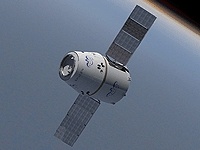Dragon spacecraft completes low-Earth orbit flight
This week, commercial space company SpaceX launched its Dragon spacecraft from Cape Canaveral into low-Earth orbit atop its own two-stage, liquid oxygen and rocket grade kerosene-powered Falcon rocket.

After orbiting the earth at speeds greater than 17,000mph, the Dragon spacecraft re-entered the Earth’s atmosphere and landed in the Pacific Ocean.

The Dragon spacecraft is comprised of three main elements: a nose cone (which protects the vessel and the docking adaptor during ascent), a spacecraft (which can house cargo) and a trunk (which provides for the stowage of unpressurised cargo, solar arrays and thermal radiators).
During the flight, many systems on the Dragon were tested for the first time in space. These included its structural integrity, precision firing of the 18 spacecraft’s own SpaceX Draco engines, telemetry, guidance, navigation and control systems, the heat shield and its parachutes.
The landing of the spacecraft marks the first time a commercial company has successfully recovered a spacecraft re-entering from low-Earth orbit. It is a feat performed by only six nations or government agencies: the US, Russia, China, Japan, India and the European Space Agency.
Register now to continue reading
Thanks for visiting The Engineer. You’ve now reached your monthly limit of news stories. Register for free to unlock unlimited access to all of our news coverage, as well as premium content including opinion, in-depth features and special reports.
Benefits of registering
-
In-depth insights and coverage of key emerging trends
-
Unrestricted access to special reports throughout the year
-
Daily technology news delivered straight to your inbox










National Gas receives funding to develop Gravitricity underground hydrogen storage system
One single rock salt mine - Winsford - has 23 <i>MILLION </i>cubic metres of void and even allowing for 10% of that void set aside for hazardous waste...